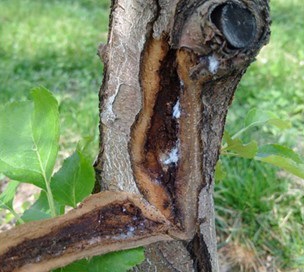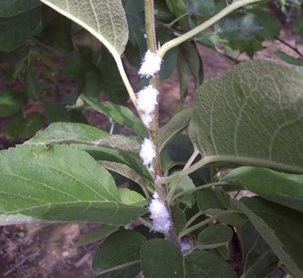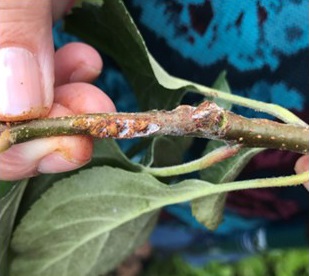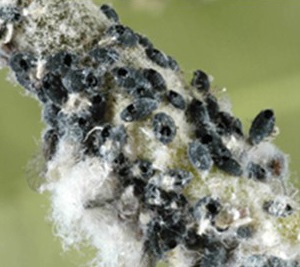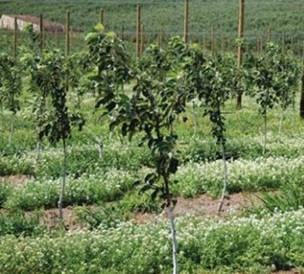Woolly apple aphid management
Learn how to identify and management options for wooly apple aphid.
The woolly apple aphid (WAA), Erisoma lanigerum has historically been considered an occasional apple pest in Ontario, but is now seen more frequently in orchards. Besides apples, other hosts include pear, hawthorn, mountain ash and elm.
There can be two colonies of WAA: aerial and underground (on roots). While aerial colonies are well established, it is debated whether underground colonies are an issue in Ontario or if the winters are too harsh for survival. There are few reports of WAA impeding root development.
Aerial colonies overwinter as eggs in bark cracks and crevices (Figure 1). In the spring, nymphs migrate up to apple shoots and tender bark areas. Colonies covered in a white, waxy coating are typically first observed in June on pruning cuts (Figure 2), around wounds of limbs and trunks and at the base of young shoots. As the summer progress, infestations increase and spread to growing twigs and leaf axils of water sprouts (Figure 3).
Crawlers can move to roots any time they are active, mainly in June and July, and in the fall. There are winged aphids, and crawlers, and both move from tree to tree. Close tree spacing and clean, smooth soil surfaces favour crawler migration. High soil temperature, weed cover and larger tree spacing inhibit movement between trees.
Woolly apple aphid feeding forms knots or galls on twigs (Figure 4) or roots. This can lead to stunting of new growth, especially on young trees. Areas damaged by WAA are also more sensitive to frost and winter injury. Where canker disease has established, aphid feeding may spread the pathogen.
Similar to other aphids, WAA excrete a sticky material called honeydew that drips on fruit and leaves. Honeydew causes russet spots on the fruit. A black, sooty fungus may establish on the honeydew, downgrading fruit quality. Honeydew is also a nuisance to harvesters because it is sticky and stains cloths on contact.
Ideally, Aphelinus mali, a parasitic wasp can completely control aerial colonies of WAA. Parasitized aphids appear as black mummies (Figure 5). Unfortunately, A. mali are very sensitive to many commonly used insecticides in conventionally managed orchards (Table 1).
| Group | Group Name | Toxicity to A. mali |
|---|---|---|
| 1A | Carbamate | Very toxic (VT) |
| 1B | Organophosphate | Very toxic (VT) |
| 3 | Pyrethroids | Very toxic (VT) |
| 4A | Neonicotinoids | Moderately toxic (MT) – Very toxic (VT) |
| 5 | Spinosyns | Moderately toxic (MT) |
| 28 | Diamides | Not toxic (NT) – Moderately toxic (MT) |
Interestingly, research has been done in Washington looking at the use of flowers planted down the middle of every alley to promote aphid suppression in orchard systems (Gontijo et al., 2013). Aphid densities were found to be significantly lower on trees adjacent to flowers than those on control plots. In particular, a diverse group of generalist-predator spiders and insects including syrphid flies increased significantly near sweet alyssum (Figure 6). The alyssum could then be mowed throughout the season or mowers were adapted to leave the center strip uncut.
Other management strategies include:
- Resistant rootstock — Malling rootstock series with numbers over 100 are generally resistant (MM.106, MM.111) as well as G.41 and G.202. However, resistance is not passed on to scion and does not impact the aerial population.
- Chemical control — There are no chemical controls for underground infestations. Apply registered insecticide sprays when aerial colonies first start to appear. Early summer management is more effective than later summer controls as the waxy covering over these pests is less and easier for insecticides to penetrate. Field observations of Movento applied at petal fall for apple leafcurling midge and again 14 days later provided good control of WAA. Aphids were also controlled well in San Jose scale trials using Closer when the high rate of 400 mL/ha was used. Reports from New York (Agnello, 2017), Pennsylvania (Biddinger, 2017) and Washington (Beers et al., 2007) suggest similar findings.
- Cultural control:
- Monitor suckers and pruning cuts between petal fall and 1st cover.
- Remove root suckers to eliminate early colonization sites.
- Remove water sprouts on major scaffold limbs early in the season (June).
- Paint large pruning cuts to discourage colonies.
- Remove larger colonies during summer pruning.
References
Agnello, A. 2017. The Usual Suspects: A Reprise by San Jose Scale & Woolly Apple Aphid. Presented at Ontario Fruit & Vegetable Convention, Niagara Falls, ON.
Beers, E.H., Cockfield, S.D. and Fazio, G. 2007. Biology and management of woolly apple aphid, Eriosoma lanigerum (Hausmann), in Washington state. IOBC/wprs Bulletin. 30: 37-42.
Biddinger, D. 2017. Orchard IPM — BMSB and Woolly Apple Aphid.
Gontijo, LM., Beers, EH. and Snyder, WE. 2013. Flowers promote aphid suppression in apple orchards. Biological Control. 66:8-15.
